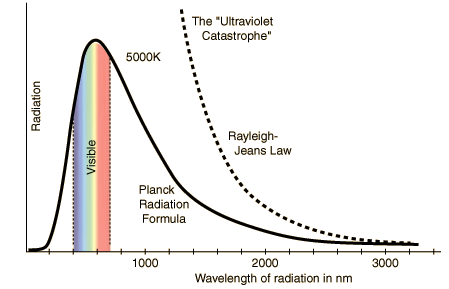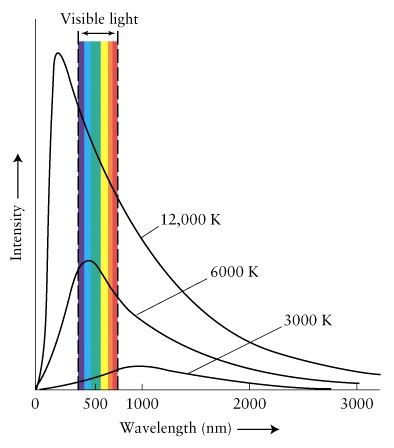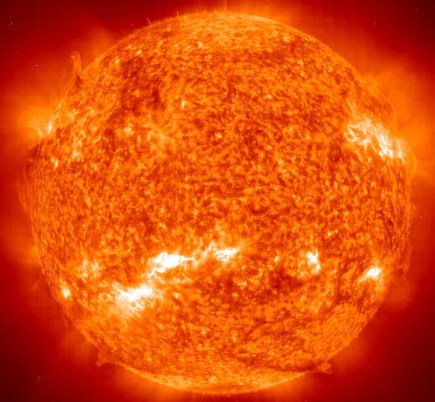Given the Following Blackbody Curve Graph What Color Will Star a Be Blue Red White Yellow
Textbook: Chapter 5
Thermal Radiation and Blackbodies
| |
Plot of Intensity of Blackbody radiation versus wavelength for T = 5,000 Yard: |
Next
Properties of the Blackbody Spectrum
- Shape of the blackbody curve is the same for all temperatures.
- As T increases, the intensity of light at all wavelengths increases.
- The wavelength with the brightest light is denoted &lambdamax
- Every bit T increase this peak wavelength becomes shorter in inverse proportion to the temperature ( Wien'south Law ):

 | |
The Colour of Stars
- Stars take spectra which are very close to a blackbody.
- The colour of a star will depend on its temperature.
The Lord's day's Spectrum
|  |
Back Next
What Colour Will a Star Appear To Accept?
Example: A star with surface temperature T = 1.ii x ten4K
|  |
Dorsum Next
Example: A star with surface temperature T = 3x103K
|  |
Dorsum Adjacent
The Energy Flux of a Blackbody
- Every bit T increases, the intensity of light at all wavelengths increases.
- The Free energy Flux of an object is the rate that free energy is emitted from a square meter of the object'due south surface.
- F = Free energy Flux
- Units of F are J/(s mii) = West/(mtwo).
- 1 Watt = 1 Joule/2d or W=J/s.
- A blackbody has an energy flux which depends only on its Temperature.
- The formula is ( Stefan'southward Law ):

- The constant "sigma" is called the Stefan-Boltzmann constant and is given past:

- The temperature in this equation is the surface temperature of the object! The object might be much hotter deep inside, but this doesn't matter.
Back Next
The Luminosity of a Blackbody
- The luminosity of a star is the power that it emits.
- Power is the charge per unit that energy is emitted by the star.
- Symbol for luminosity is "L".
- Units for luminosity are Watts = W.
- The luminosity is equal to the Free energy Flux times the surface area of the object (if F is constant over the object).
Fifty = F x A
- A spherical object, such as a star has a surface surface area, A, given by
A = iv &pi R2
where R is the star's radius.
- If the star is a blackbody, so its power output or luminosity is
L = iv &pi R2 &sigma T4
- The luminosity of a star depends both on its temperature and on its size. The larger and hotter it is, the more powerful information technology will be.
Dorsum
Next Lecture: Atomic Spectra
Read 1st Ed. pages 105 - 118 or 2nd Ed. pages 103 - 114
Source: https://sites.ualberta.ca/~pogosyan/teaching/ASTRO_122/lect4/lecture4.html

0 Response to "Given the Following Blackbody Curve Graph What Color Will Star a Be Blue Red White Yellow"
Enregistrer un commentaire